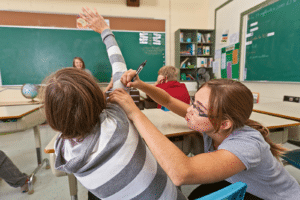When we look back at the jobs that were dramatically impacted by COVID-19, teachers are at the top of the list. Overnight, they went from a primarily relational and hands-on teaching school setting, to a virtual, distant-learning, environment. Then consider the work it traditionally takes to prepare a daily class program and how you will deliver it to transitioning “one the fly” to a remote and mostly self-study program. Add to that the unknown of dealing with new technology, the varied response of the students and their family environment, and you have a glimpse of the stress teachers have experienced since shelter-in-place was implemented in March.
Kristeena Dewberry and Kim Sayers are two licensed professional counselors (LPC) who have seen it first-hand in their roles at Communities In Schools – San Antonio (CIS-SA). Kristeena is a Coach for teachers for a pilot program with three Northeast ISD schools deployed by CIS-SA in partnership with Clarity Child Guidance Center. Kim is the Director of the Counseling team at CIS-SA. In a recent interview, I asked them what they saw and what seemed to help teachers during these unprecedented times.
What it was like
Teachers’ experiences varied depending on what and who they taught. For some classes with high performing independent learners who were strong in self-study and utilized the content and tools provided, it was possibly easier. The teacher could post the goals, provide the lesson, and check the work done in their own schedule.
Major challenges came for classes where a lot of teacher-student interaction is required. When you interact in the classroom, the response is immediate. Not in the virtual world. Students would respond late in the day. Teachers then were challenged to respond right then or wait until the next day. Because many of the teachers have family responsibilities of their own, it created boundary issues and tensions. Or they felt guilty for not responding in time. Susan Arciniega LCSW, LMFT, Mental Health Behavioral Specialist at SouthSan ISD and a mother of three, runs a health advisory board with their high school students. Since a number of her students started a job during COVID-19 to help their family, she talked to them as a late as 11 pm on a regular basis.
The virtual setting made it more difficult to motivate students who are not self-driven or have a less supportive family environment. It’s even more pronounced with younger students: how do you make a 7 year old complete a task via a virtual call? How do you get a hold of parents when there is a problem? Some older students simply didn’t show up for a variety of reasons: work, challenging family issues, or mental illness. Working out accommodations for Special Education students was complex and not always possible in the new format, so it fell on parents.
How teachers responded
Kristeena reports she saw “everything from struggling to striving.” It depended on multiple factors. For instance, if your spouse lost her job, the stress at home was higher. People who had a solid self-care plan and structure did better, but it wasn’t always enough. For some going to work was a way to cope with a complicated home life and that went away. Teachers whose experiences seemed “easier” wondered if they were pulling their weight compared to struggling colleagues – even when they still did.
An example of someone who did great was Kim’s daughter’s elementary teacher. “She organized two daily Zoom classrooms, was very interactive and quick to respond to my daughter, even organized a Zoom party and dropped stuff at our house.”
What worked for teachers
All along the crisis Kristeena was pro-actively coaching teachers, organizing small group discussions for support, sending daily encouraging emails. Here are a few lessons she saw for people who seemed to do well:
- They worked as a team with their spouse/partner to take time away from work (like taking a walk)
- They created community: connected regularly with friends and colleagues
- They took breaks
- They maintained a routine
- They adopted new activities (my neighbor, a professor at Trinity University took on skate board and he goes out with his wife and kids at 5 pm every day).
Looking now at this overall difficult experience, Kim and Kristeena noticed that it brought a lot of self-awareness to teachers about their needs, strengths and weaknesses. Another silver lining is that some students who were shy became more engaged with the new class format.
“People miss their students” said Kristeena, and if there is a safe way they will be glad to return to the classroom. Some have valid concerns about their own health and staying safe. Maybe the future is a hybrid. In any case, we hope teachers continue to strive and know that parents have gained a new appreciation of their work and the gift they are.










